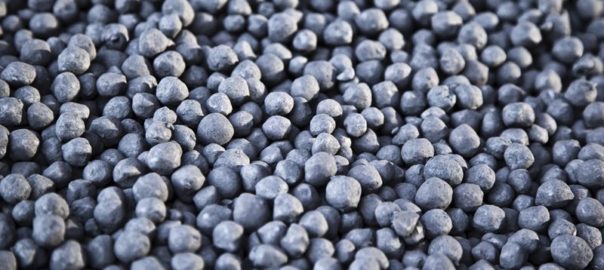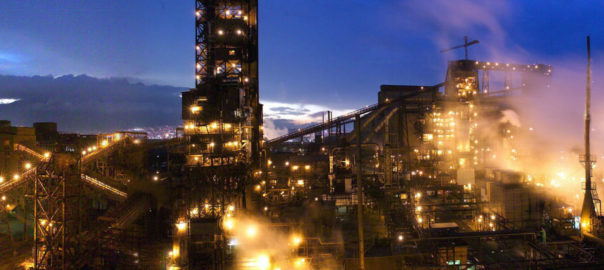A joint initiative between LKAB, SSAB and Vattenfall to develop the world’s first fossil-free steelmaking process is gaining momentum, with construction of a biofuel-based pelletising plant shortly beginning at the iron ore miner’s Malmberget site, in Sweden.
This “world-unique test facility”, a key component of the HYBRIT initiative, will see fossil fuels replaced with biofuel to achieve fossil-free production of iron ore pellets.
The aim of HYBRIT, which is supported by the Swedish Energy Agency, is to develop a process for fossil-free steelmaking by 2035.
In 2018, the Swedish Energy Agency announced it would contribute funding amounting to more than SEK500 million ($54 million) towards the pilot-scale development of an industrial process, with three owners, LKAB, SSAB and Vattenfall, each contributing a third of the outstanding capital for the project.
LKAB said: “Fossil-free steel production starts at the mine and LKAB is working hard to determine the design of the next generation of pelletising plants.”
Back in October, Tenova HYL was contracted by HYBRIT to supply its direct reduced iron solution as part of the project.
The biofuel-based plant, to be built near to LKAB’s Malmberget iron ore mine, will cost in the region of SEK80 million.
“Testing a bio-oil system is part of the pilot phase and the objective is to convert one of LKAB’s pelletising plants from fossil fuel to 100% renewable fuel,” the company said. “This means that fossil-generated carbon dioxide emissions from the Malmberget operation will be reduced by up to 40% during the test period, which corresponds to about 60,000 t/y. Eventually, LKAB hopes to achieve totally carbon-dioxide-free pellet production.”
Jan Moström, LKAB’s President and CEO, said: “Within HYBRIT, LKAB is examining options for replacing the heating technologies used in the pellet process, which are the heart of our processing plants. In parallel, trials will be conducted in an experimental facility in Luleå using an alternative heating technology. Trials will determine whether new biofuels and plasma burners will work in the unique setting of a pellet plant. Ultimately, this will make LKAB’s iron ore pellets completely carbon-dioxide-free.”
The global iron and steel industry is one of the industrial sectors whose processes emit the most carbon dioxide, according to LKAB. “A growing population, in combination with greater urbanisation, means that demand for steel will continue to grow until 2050. If the HYBRIT initiative succeeds, Sweden’s carbon dioxide emissions will decrease by 10%,” the company said.
Mårten Görnerup, CEO, Hybrit Development AB, said: “The initiative is decisive for Sweden’s ability to meet the targets set out in the Paris Agreement and nationally, and it is our contribution to battling climate change. Fossil-free production of iron ore pellets is an important step towards reaching these goals.”
Following a pre-study conducted in 2016–2017, the first sod was turned in 2018 for a pilot plant for hydrogen-based reduction of iron ore in Luleå, Sweden. This plant, expected to be completed in 2020, will be used to test processes downstream from the pelletising plant. The investment in a pilot-plant for bio-oil in Malmberget, which is an important milestone for HYBRIT and the development of fossil-free pellet production, is expected to be completed by 2020. The first tests will be conducted up to 2021.
Magnus Hall, President and CEO, Vattenfall, said: “Our partnership with SSAB and LKAB is playing a very important role in the electrification of the industry and the development of fossil-free hydrogen to enable a fossil-free life within a generation.”
Martin Lindqvist, CEO and President of SSAB, said the partners are on their way to a revolutionary technical advancement, “showing the world that it is possible to produce steel without producing carbon dioxide emissions”.
He added: “Work is proceeding according to schedule and I am confident that we will succeed. As a first step toward creating a fossil-free SSAB, we have decided to switch to an electric arc furnace in Oxelösund. This will entail decommissioning both blast furnaces in around 2025 and will reduce our CO2 emissions in Sweden by around 25%,” he said.
The primary goal of HYBRIT is to eliminate fossil-generated carbon dioxide emissions and thereby stop the net increase in carbon dioxide in the atmosphere. This will be done by converting to renewable fuel.
In the next step, LKAB’s vision is to fully eliminate carbon dioxide emissions from the pelletising plants. LKAB’s iron ore consists largely of magnetite and, even without the use of bio-oil, it already gives the company a big environmental head-start on competitors, according to the company.
Steel produced from 100% LKAB iron ore pellets results in carbon dioxide emissions that are 14% lower when compared to steel manufactured at an average European sinter-based steel mill. “One explanation is that it requires less energy to make pellets from magnetite than from the more commonly occurring hematite. The pellet process currently requires a lot of energy, while a very great amount of heat is released when magnetite is converted to hematite.”







